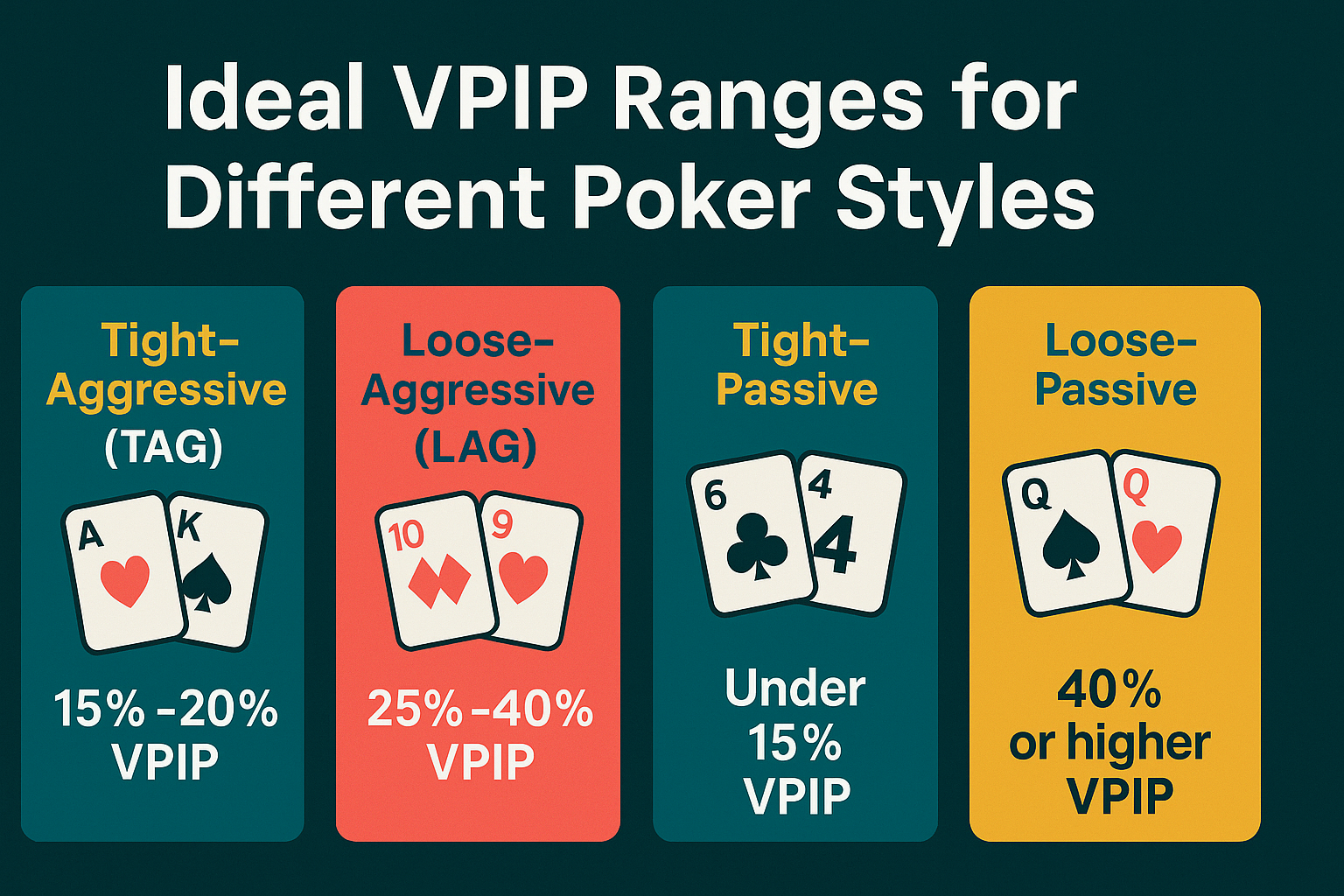
What’s the deal with ClubGG VPIP? If you’re wondering what VPIP (Voluntarily Put Money in Pot) means and how to use it to crush your games, you’re in the right place. Simply put, VPIP tells you how often a player puts money into the pot before the flop. If you’re playing on ClubGG or any other poker app, this stat can help you get a solid read on your play and your opponents’. Is your VPIP too high? You’re probably playing too many hands, and it’s time to tighten up. Too low? You might be missing opportunities to get in on profitable pots. Understanding and adjusting VPIP is key to becoming a smarter and more strategic poker player. In this guide, we’ll break down the meaning of VPIP, how to use it to analyze your game, and how to adjust your play to improve your results.
What is VPIP?
At its core, VPIP is a simple percentage that tracks how often a player voluntarily invests money in the pot before the flop. Here’s the formula for VPIP:
VPIP = (Number of hands where you voluntarily put money in the pot ÷ Total hands played) × 100
Or in formula format:
VPIP = (Voluntary Hands / Total Hands Played) × 100
The number you get from VPIP reveals a lot about your playing style. Are you aggressive and willing to play a wide range of hands, or do you sit back and only play premium hands? Understanding this is key to your success on platforms like ClubGG.
What Does VPIP Tell You About a Player?
- High VPIP (Loose Players): Players with a high VPIP are playing a lot of hands, often even the weaker ones. High VPIP players are loose and more unpredictable. For example, a VPIP of 40% or higher means this player is aggressive and plays a wide range of hands.
- Low VPIP (Tight Players): On the flip side, a low VPIP (under 15%) means the player is tight. They only enter pots with strong hands. These players are more selective, so you can expect them to play more cautiously and rarely get involved with marginal hands. On
- ClubGG, identifying low VPIP players is crucial because it allows you to adjust your strategy and exploit their more conservative approach, especially when they’re unlikely to defend with weaker hands.
Ideal VPIP Ranges for Different Poker Styles

Here’s a quick breakdown of VPIP ranges for different playing styles:
- Tight-Aggressive (TAG): 15% – 20% VPIP
TAG players are selective about the hands they play but play those hands aggressively. They usually raise pre-flop and are selective with their ranges.
- Loose-Aggressive (LAG): 25% – 40% VPIP
LAG players play a wider range of hands and are aggressive, making frequent raises and bluffing. This strategy puts pressure on opponents, forcing them to make mistakes.
- Tight-Passive: Under 15% VPIP
These players fold more than they should. They wait for strong hands and rarely enter pots unless they have a premium hand.
- Loose-Passive: 40% or higher VPIP
These players are in almost every hand but don’t make aggressive moves. They tend to just call rather than raise, waiting for strong hands.
How to Use VPIP to Analyse Your Play
– Self-Analysis with VPIP
Using ClubGG VPIP for self-analysis is a great way to keep tabs on your game. Here’s what to look for:
- Are you playing too many hands?
If your VPIP is over 30%, it could mean you’re being too loose. Tighten up and start folding marginal hands that you’d normally call with. A high VPIP can lead to trouble, as you’ll end up getting caught with weak hands more often than you’d like.
- Are you being too tight?
On the other hand, if your VPIP is too low (under 15%), it may be time to open up your range. Especially in late positions, you can afford to play more hands, as you have more information about the other players’ actions.
– Adjusting Your Strategy Based on VPIP
If you’re playing too many hands and have a high VPIP, try to tighten up your play. Consider reducing the number of marginal hands you play, particularly in early positions.
If you have a low VPIP, try adding more hands to your range, especially in late position when you have more information on the other players’ actions.
– The Impact of Position on VPIP
Your VPIP should be adjusted based on your position at the table. In early positions, you should have a lower VPIP because there are more players to act after you. In late position, you can increase your VPIP since you can act with more knowledge of how the table is playing.
How to Use VPIP to Analyze Your Opponents
– Spotting Player Tendencies with VPIP
Once you’ve understood VPIP, you can use it to analyze your opponents. Here’s how:
- High VPIP (Loose Players): If an opponent has a high VPIP, they are playing more hands, which means they could be overvaluing weaker hands. Use this information to trap them, let them bet into you with weaker hands, and then strike with your stronger ones. To maximize your edge, you should consider how to exploit loose players when you play ClubGG online, where such tendencies can be easier to spot and take advantage of.
- Low VPIP (Tight Players): Low VPIP players only play premium hands. They might not play many hands, but when they do, you can be sure they have a strong one. You can exploit them by being more aggressive and applying pressure when they show weakness.
– Adjusting Your Strategy Based on Opponent VPIP
- Against Loose Players: Tighten up your VPIP and only enter pots with strong hands. You can use their loose play against them by waiting for strong hands and raising aggressively when you do.
- Against Tight Players: Loosen your VPIP slightly and increase your aggression, especially in late position. They will often fold marginal hands, so you can steal more pots.
– Combining VPIP with Other Stats
VPIP is powerful on its own, but combining it with stats like PFR (Pre-flop Raise), Aggression Factor (AF), and Fold to 3-Bet will give you a fuller picture of your opponents’ tendencies. For example, if someone has a high VPIP and a high PFR, they’re probably a LAG player. If their VPIP is high but their PFR is low, they’re likely calling too many hands and not being aggressive enough.
Common VPIP Misconceptions
– VPIP Isn’t Everything
While VPIP is important, it’s just one part of the puzzle. Relying solely on VPIP can be misleading, as it doesn’t tell you how players are acting post-flop. VPIP combined with AF, PFR, and 3-bet stats will give you a clearer picture of the players’ styles.
– What’s a “Perfect” VPIP?
There’s no such thing as a perfect VPIP. The ideal VPIP will vary depending on your playstyle, table dynamics, and even the specific poker variant you’re playing. For most players, a VPIP between 18%-25% is solid, but the key is balance, don’t focus too much on the number itself.
Advanced Tips for Using VPIP to Crush Games
– Adapting Your VPIP Based on Table Dynamics
- Full Ring vs. Short-Handed: In full-ring games, your VPIP should be lower due to more players at the table. In short-handed games, you can afford to widen your VPIP and play more hands.
- Fast Tables vs. Slow Tables: On fast tables, you’ll need to tighten up your VPIP since blinds increase faster, while slow tables give you more time to adjust your strategy.
– Exploiting Opponents’ VPIP
Use VPIP to create bluffs against loose players. If your VPIP is high and they see you as a loose player, they may start folding to your bets, even with weak hands. Conversely, when facing tight players, open up your range and be more aggressive.
FAQs
What is a good VPIP for poker?
A good VPIP depends on your playing style, but generally, 18%-25% is considered solid for most players. If you’re playing tight-aggressive (TAG), aim for the lower end. For loose-aggressive (LAG) play, you can go higher.
Can VPIP help me win more poker games?
Absolutely! By using VPIP to adjust your play, you can make more informed decisions. Understanding both your own and your opponents’ VPIP allows you to exploit weaknesses and optimize your strategy.
How often should I adjust my VPIP in a game?
Adjust your VPIP based on the players at your table and your position. If you’re playing against loose players, tighten up your range. If you’re facing tight players, widen your range, especially in late positions.
Ready to play?
Find your next poker club in seconds at BluffingMonkeys.com/club-list. Our live-chat crew is on standby 24/7 to walk you through a blazing-fast signup.
See you at the tables. Visit BluffingMonkeys.com for exclusive bonuses, promotions, club announcements, blogs, strategy breakdowns, free poker tools, and much more.
